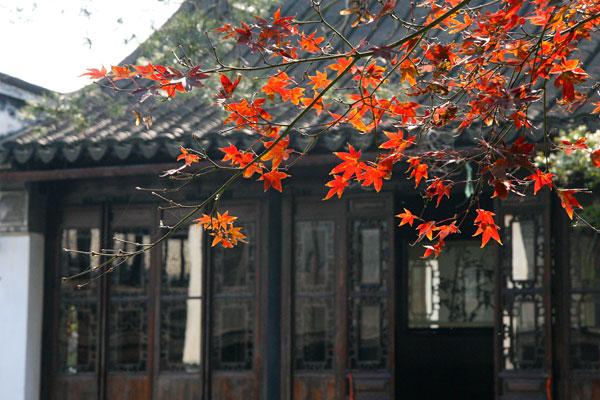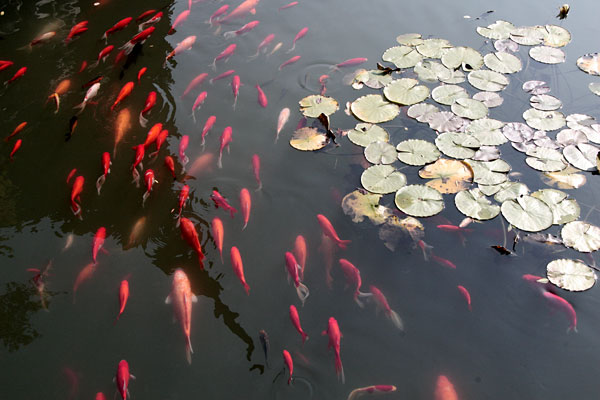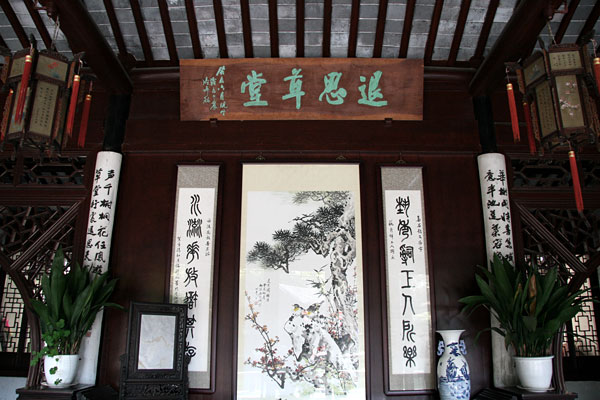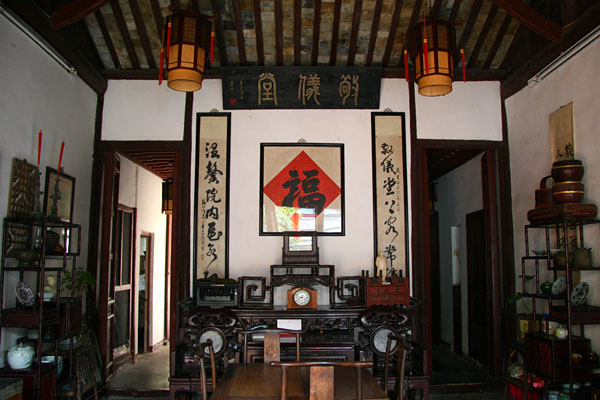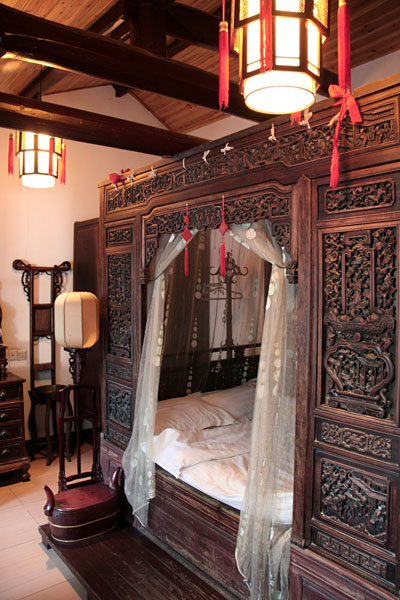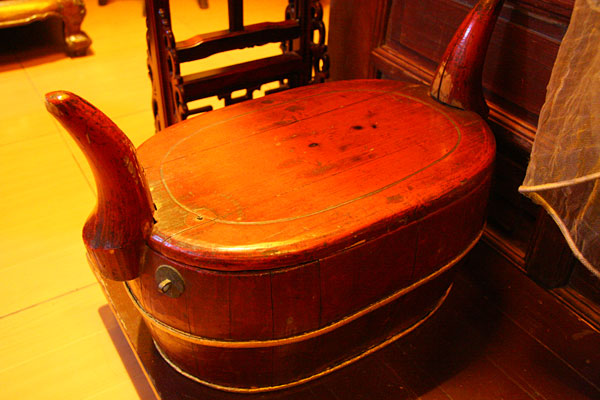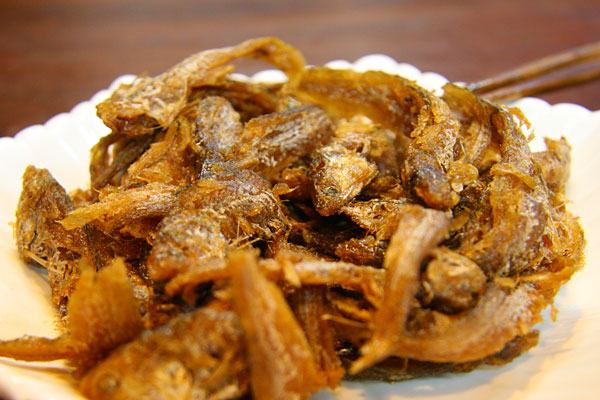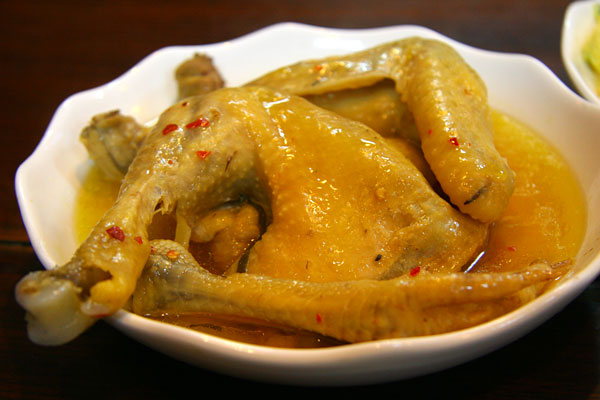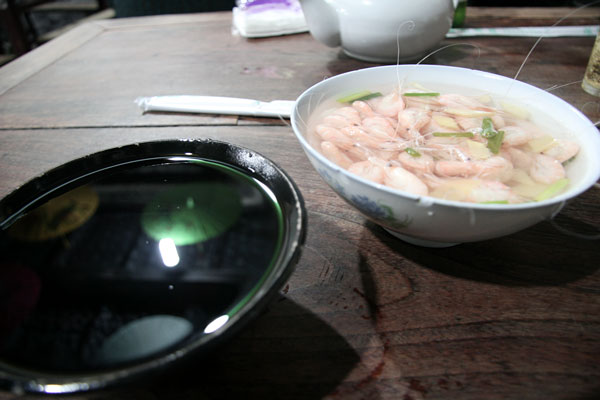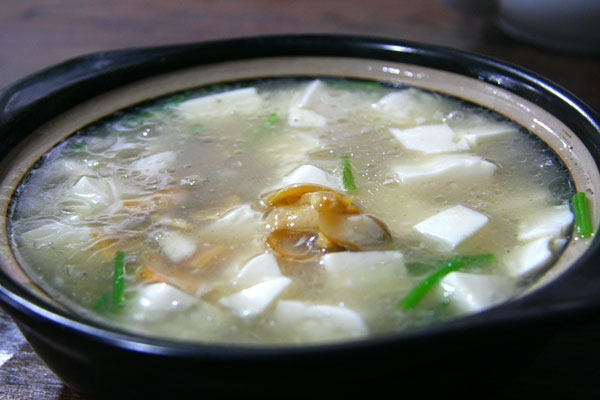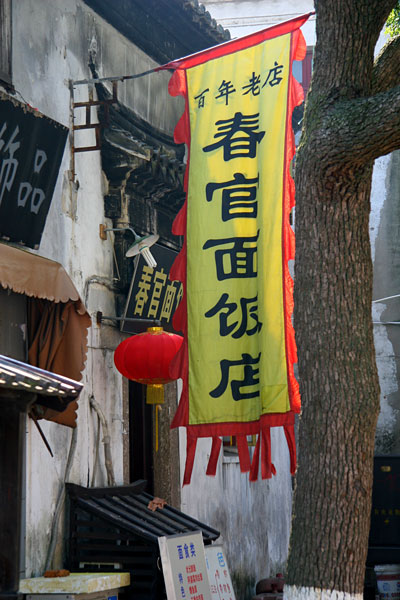
The food, above the gardens, was actually my favorite memory of Suzhou.
IMHO visitors place too much attention on her immaculate, World-Heritage-worthy classical gardens, and end up missing the taste of an ancient culinary tradition, 2500 years in the making and highly esteemed among Chinese cuisine. Chinese gourmands may associate Suzhou with the nationally famous Hairy Crabs of Yangcheng Lake (see our upcoming article on Crab Caviar tasting at a crab farm). But even within central Suzhou you'll find a multitude of excellent restaurants ranging from RMB 20 to 250 (CAD$3 to $40) per head. Again we consulted the locals, and were directed to three authentic and highly reputed restaurants in town.
Food Review: WUMEN RENJIA, Main Branch (Suzhou)
Address: Panru Alley 31, Pingjiang District, Suzhou
Hours: 06:30-13:30, 17:00-20:30
Website/Map: Map from Google
Directions:Start from the front entrance of Lion Grove Garden. Walk north along Yuanlin Road and turn left onto the first alley (Panru Alley). Wumen Renjia is immediately on the right, behind an intimidating rack of medieval wooden fences.
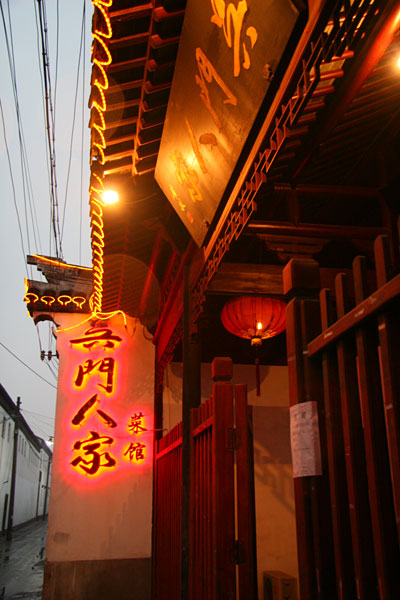
This is currently reputed to be the best restaurant in Suzhou, overtaking the historic Songhelou according to many local gourmands. Architecture fans also know this place as the childhood home of the great I.M. Pei. Housed inside a magnificent Qing Dynasty mansion just steps from the gorgeous Lion Grove Garden, Wumen Renjia is so well-camouflaged inside an old-fashioned neighborhood that we would have never found this place on our own without directions from the locals.
This is a restaurant best known for its strict adherence to 100-year-old recipes in the grand culinary tradition of Suzhou, and patrons are seated in an airy dining hall of giant wooden pillars and antique carved beams. Once again we employed our usual strategy -- focus only on the most traditional, time-honoured local dishes that earned the restaurant its fame. As a result all of the dishes reviewed below are arguably among Suzhou’s most famous dishes, starting with the Stir-Fried Shrimp in Clear Sauce (Qingchao Xiaren).
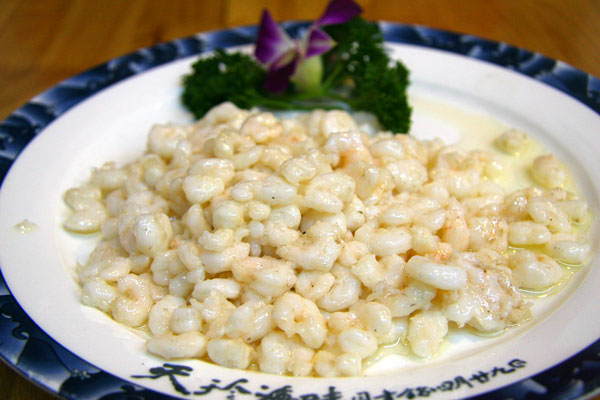
In one of the simplest and most representative of Suzhou dishes, this heap of sweet freshwater shrimp were individually shelled by hand, coated in a creamy mixture of starch and egg white, stir-fried in oil and finally served with a side dish of aged rice vinegar. This was actually very similar to the Longjing Shrimp we had a few days ago at Hangzhou’s Xihu State Guesthouse, but posessing a slightly rougher texture and an oilier mouthfeel balanced perfectly by the acidity of the dipping vinegar. As a metaphor I thought of the Longjing Shrimp as more of a delicate feminine dish, contrasted against this bolder, masculine version. It’s no wonder that my wife let me finish most of this dish, as I was the one who thoroughly enjoyed it.

Even better was this incredible dish of Braised Eels in Sizzling Oil (Xiangyou Shanhu). As a foodie I’m crazy about the taste of Unagi, or freshwater eel ... crazy enough to travel to specialty restaurants in Tokyo, to Osaka and to Nagoya for the different regional styles. And this time in Eastern China one of my most anticipated dishes was the local specialty of Shanhu, made from the small yellow eels indigenous to the area. This is perennially my favorite dish in Shanghainese restaurants in Hong Kong and elsewhere, and I was anxious to taste the real thing at what’s reputed to be one of Eastern China’s top restaurants.
And it did not disappoint -- this was easily among the best freshwater eels I’ve ever had, in any nationality or genre of preparation. The characteristic fattiness of the eels was already perfectly complimented by the savory glaze of soy, yellow wine and a dollop of white peppercorn, before our server came with a large spoonful of sizzling garlic-scallion mixture to generously slaver on top of the eels in front of our eyes. Immediately the dining hall was filled with an aroma so magical that all neighboring tables glanced our way at this spectacular dish, the oil still bubbling and the eels still searing on the scorchingly hot ceramic plate. This one dish alone would be enough to make Suzhou worthwhile for me. It’s that good.

After two oilier dishes it was time for a traditional palate cleanser, arriving in the form of this Water-Shield and Three Shredded Delicacies in Broth (Sansi Chuncai Tang). A small, lotus-like aquatic plant often found floating in local ponds, the water-shield is treasured as a delicacy here in old-fashioned Suzhou as opposed to being a feared invasive species in the United States. Perhaps this is the solution -- if only someone could fabricate a TV health fad to convince the American public to love the slimy, slip-down-your-throat texture of these tender green leaves.

Arriving next was another dish synonymous with Suzhou cuisine, the Deep-Fried Yellow Croaker in Squirrel Form (Songshu Huangyu). I was actually a little disappointed when the plate arrived, as our fish was somewhat skewed to one side and the incisions made on the sides of the fish weren’t good enough to produce the desired “squirrelly” appearance after the battering and deep-frying. But perhaps I was being hypercritical, as the batter was still perfectly crispy and the vinegar counterbalanced any residual oiliness in the meat very well. My wife thought highly of this dish, and as long as the slightly botched visual presentation was overlooked, I had to agree that the flavor was indeed outstanding.

The absolutely most amazing dish of the night was this tiny 4cm x 4cm square of pork, a personalized appetizer portion that commanded the same price (RMB 42) as our lunch for two earlier that day. But it was worth it -- this was the 120-year-old recipe of Empress Cixi’s Cherry Pork (Cixi Yingtao Rou), the best pork I’ve ever tasted so far in my life.
This was as perfect and as meticulous as a cheap piece of pork could be prepared: start with a perfectly square piece of 5-layered pork belly and make precise checkerboard incisions on the skin side, with each cut terminating at the perfect depth right where the top fatty layer meets the first lean layer of meat. Marinate with the regional specialty of red fermented rice paste, yellow wine from the glutinous rice of Shaoxing, rock sugar, aged vinegar and whatever secret ingredient passed down from the imperial chefs of the Qing Dynasty court, then finally simmer for a whole day from morning to dinner time until all the excess fat has been drained from the meat.
The result was a delicate, melt-in-your-mouth combination of the sweet and chewy skin, two thin layers of reduced fat, and two layers of slow-cooked lean meat that would all disintegrate in the mouth under the softest bite. One might think of this as more of a male carnivore’s favorite, but it was surprisingly light considering its origin as a solid chunk of fatty pork. Even my wife agreed that this was the most memorable dish of our time in Suzhou.

By this time we had already ordered way too much food, and we made the mistake of ordering yet one more of Suzhou’s best-known dishes. It was crab caviar season and the restaurant was selling Hairy Crabs from the nearby Tai Lake for RMB 158 a pair. As we planned on traveling to Yangcheng Lake for the famous Big Sluice Crabs (Dazhaxie) the next day, we decided to order the Tai Lake variety here as a legitimate comparison.
The crabs turned out to be somewhat average -- neither the female nor the male crab produced a large amount of yellow caviar, though the amount of white caviar in the male crab saved the day. I still thought they weren’t worth their price tag however, as I’ve had better Hairy Crabs for far cheaper prices in other Chinese cities, and not necessarily in Eastern China. Just the luck of the draw I guess.

A memorable episode began when we asked for scissors to clip off the legs, which I thought was the typical way to start shelling Hairy Crabs in most Chinese cities. Our waitress laughed, and to our surprise brought out the owner’s wife to personally teach these unrefined barbarians how to properly eat Hairy Crabs at the birthplace of Hairy Crabs! Here we re-learned the process of twisting and separating each segment of the leg, and inserting the smaller segments into the shells of the larger segments to push out the meat. Pictured is my wife’s attempt to reassemble part of the crab after she had finished all the caviar and meat inside. As for me, I think I proved once again that my lack of manual dexterity was beyond help.
This wasn’t a cheap meal -- in fact it was the second priciest of our 17-day trip, owing largely to the Hairy Crabs before which we should have stopped. We’ve got no regrets though, as the both the Braised Eels and the Cherry Pork were among our most memorable dishes, extraordinary enough to be reasons for another trip to Suzhou. The quality of food was amazing -- as long as you stick to their best dishes -- and I have no hesitation recommending this restaurant to anyone interested in the flavors of Old Suzhou.
Bill for Two Persons
| Stir-Fried Shrimps in Clear Sauce | RMB 58 |
| Braised Eels in Sizzling Oil | RMB 68 |
| Water-Shield and Three Shredded Delicacies in Broth | RMB 28 |
| Deep-Fried Yellow Croaker in Squirrel Form | RMB 138 |
| Empress Cixi's Cherry Pork (Small) | RMB 42 |
| Steamed Big Sluice Crab (One Pair of Male/Female) | RMB 158 |
| Draft Beer | RMB 12 |
| Rice | FREE |
| TOTAL | RMB 502 (CAD$79.7) |
Suzhou isn’t just about expensive, RMB 500 meals of imperial court-influenced dishes. Equally renowned is the 1000-year-old peasant favorite of Lamian (later transliterated to Ramen by the Japanese) noodles typically sold in neighborhood noodle house for RMB 10 to 15 a bowl. Again we followed recommendations from the locals and visited two of the best-known noodles houses in town.
Food Review: TONGDEXING (Suzhou)
Address: Jiayufang 6, Pingjiang District, Suzhou
Hours: 06:00-13:00
Website/Map: Map from Google
Directions: Start from the front entrance of Yiyuan Garden (just north of Leqiao Metro Station), walk north along Renmin Road then turn left at the first street (Jiayufang). Tongdexing is about 50m down the street on the left side.

If having a knock-off clone is the ultimate sign of commercial success in 21st Century capitalist China, this unpretentious noodle house must be among the best in the country.
Started out as a neighborhood joint in Suzhou barely 20 years ago, Tongdexing has famously attracted imitators as far as Shanghai, bold enough to also call themselves Tongdexing with a slightly different character of “De” in the name. I can’t quite remember the end result of the ensued lawsuit, but I did make a mental note that I must visit this place sometime.
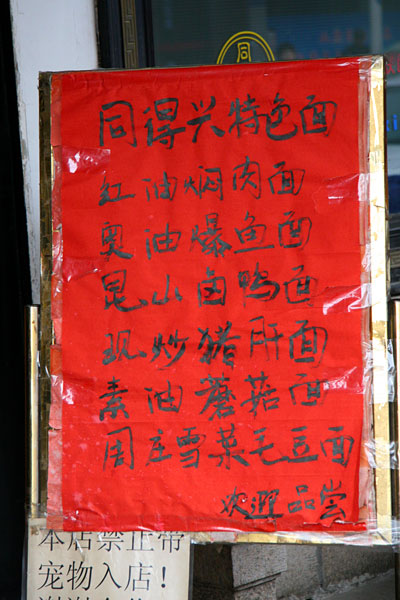
As we arrived in Suzhou in late 2012, Tongdexing had already expanded into a small franchise across the lower Yangtze Delta, with its main branch still centrally located just north of the popular Yiyuan Garden. No colorful advertisements were in sight, and instead a traditional red sheet with badly hand-written calligraphy was used to indicate the seasonal specialties available at this time. No English menus here ... just point at whatever the locals are having. If you want an authentic breakfast/lunch experience in Suzhou, this is probably as close as it gets.

Ordering food was the easy part -- the tough part was lining up for 10 minutes at the window and continuously tempted by the incredibly deep aroma emanating from the giant vats of soup stock. While Tongdexing is well-known for two distinct soup stocks unimaginatively named Red Broth and White Broth, only Red Broth remained when we arrived at 11:00 in the morning. It’s better to be here early, as the soup stock sells out quickly and the place typically closes by 13:00. It’s that popular.
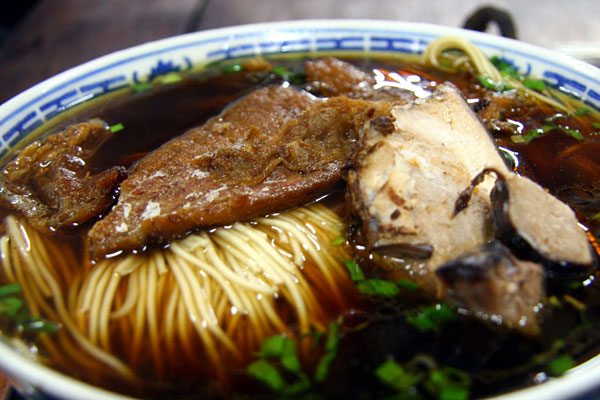
Here it is, our Noodles in Red Broth with Simmered Pork (Hongtang Menroumian) with a side order of Deep-Fried Fish in Dark Oil (Aoyou Baoyu). These remarkably thin noodles were clearly designed to soak up the flavorsome broth made from eel bones and pork bones, and had an extremely chewy al dente texture achieved through a quick drench in cold water. The famed Simmered Pork was lightly marinated and tenderly slow-cooked, but even better was the syrupy goodness of the fish fillet, which came without any hint of a "muddy" flavor even though it must have been a freshwater fish at this price.
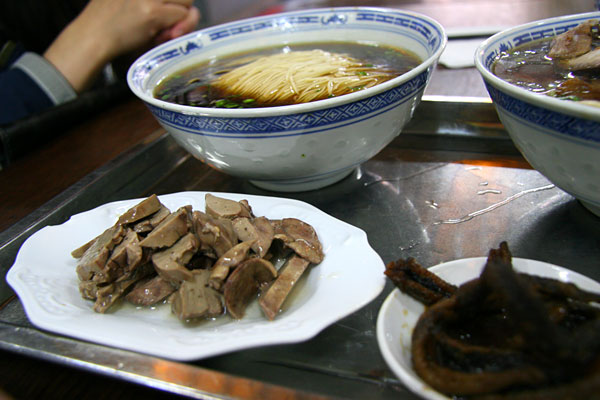
Equally delicious were these Deep-Fried Eels in Sesame Oil (Maxiang Baoshan), in a sweet, almost candied form carefully set aside from the noodles to prevent from over-soaking. The only unremarkable dish was the Duck Foie Gras, which made me even more curious about their other regional offerings such as the appetizingly sounding Smoked Duck.
But most amazing was the bargain basement price. A simple lunch of Noodles with Deep-Fried Fish would set you back a measly RMB 10 (CAD$1.6), and even our premium two-topping noodles averaged only RMB 21 per person. And remember that we’re right at the expensive city centre of Suzhou -- try finding lunch for RMB 21 at Shanghai’s East Nanjing Road!
Bill for Two Persons
| Noodles in Red Broth with Simmered Pork | RMB 9 |
| Deep-Fried Fish in Dark Oil | RMB 11 |
| Noodles with Deep-Fried Eels in Sesame Oil | RMB 15 |
| Duck Foie Gras | RMB 7 |
| TOTAL | RMB 42 (CAD$6.7) |
The next night we came back from Yangcheng Lake loaded with too much cholesterol from all the Crab Caviar we had for lunch. For a light dinner we visited yet another popular Suzhou noodle house, this one conveniently located next to the tourist district of Shantang Street.
Food Review: DONGWU MIANGUAN (Suzhou)
Address: Shantang Street 18, Jinchang District, Suzhou
Hours: 11:00-21:00 (unofficial; based on observation)
Website/Map: Map from Google
Directions: Start from the eastern entrance of Shantang Street (look for the traditional pavilion with a stone stele inside). Walk south and cross the bridge, then walk another 30m down the street. Dongwu Mianguan is on the right hand side.
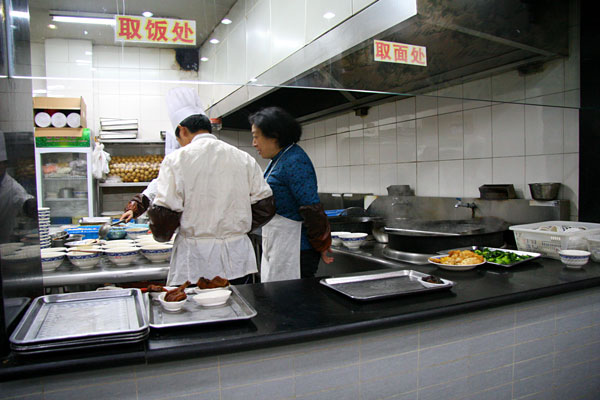
This is noodle-crazy Suzhou’s answer to the fast-food franchise, an ever-present chain of peasant eateries you’d find in most city neighborhoods. We passed by at least three branches of Dongwu Mianguan during our short time here, and decided to visit one and compare its food against our excellent lunch at Tongdexing. Those might be large shoes to fill, but if they’re good enough to sustain 30 stores across this medium sized city, they must be doing some things right.
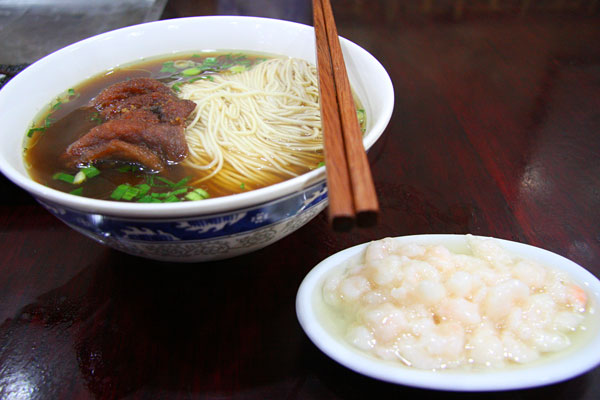
And here’s what they’re doing right -- good quality noodles at affordable prices. Once again we splurged on the premium two-topping noodles, in this case a bowl of Noodles with Deep-Fried Fish and Stir-Fried Shrimp. The noodles were surprisingly similar to those at Tongdexing: extremely thin, disproportionately chewy with a maximized surface area to saturate itself with the soup. While the soup was nowhere as deep and complex in flavor as Tongdexing’s Red Broth, the toppings were larger in portion and the overall quality was quite decent.
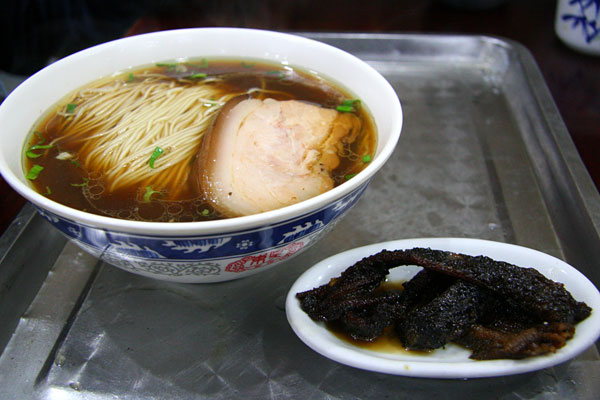
We originally wanted a dish of Braised Eels, but they ran out of fresh eels and we settled for the ubiquitous deep-fried variety. Again the difference in quality wasn’t huge compared to the same dishes at the outstanding Tongdexing, which was only open for breakfast and lunch. If you’re looking for a cheap place for an authentically Suzhou dinner at a convenient location, this is a pretty good option.
Bill for Two Persons
| Noodles with Deep-Fried Fish Fillet and Stir-Fried Shrimp | RMB 23 |
| Noodles with Deep-Fried Eels and Simmered Pork | RMB 22 |
| TOTAL | RMB 45 (CAD$7.1) |
What you want even cheaper eats?? No worries. Just north of Dongwu Mianguan, the pedestrian zone of Shantang Street is a great place to try out Suzhou’s cheap street snacks in a gentrified and relatively hygienic environment.
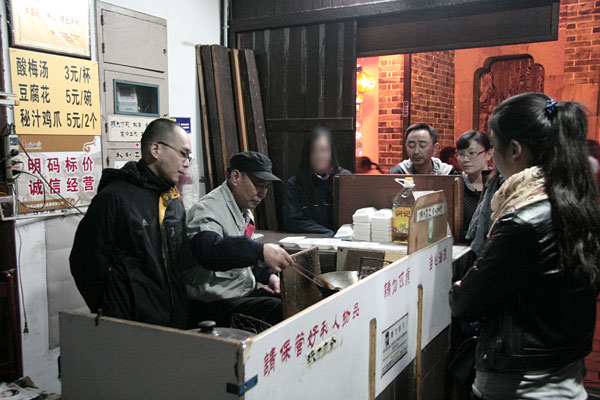
My favorite was a little Stinky Tofu shop located in the middle section of the pedestrian street. I don’t have a picture of the storefront, though it should be easy enough to simply follow the crowd of locals swarming around the counter.

Note the English, Japanese and Chinese labels at the dipping sauce station, and you know how incredibly popular this place is. Simply line-up outside the store, indicate (English is okay; hand signals if necessary) the number of orders when asked, and pay the RMB 5 per order when your line gets to the cashier.

This is what the multi-national clientele all wait in line for -- authentic Stinky Tofu, with the complex, slightly pungent flavor that has become increasingly rare in Hong Kong or even urban Shanghai due to the unpopularity of the highly odorous fermentation process. Even here the stink had been somewhat toned down, but the tofu was silken soft and the flavor was quite enjoyable.
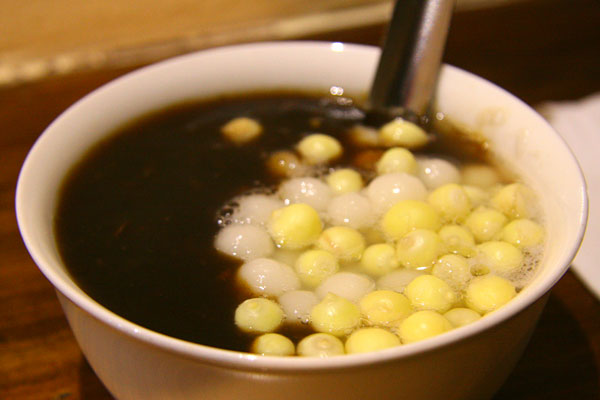
We wrapped up the evening with dessert at a nearby shop specializing in the timeless local favorite of sweet soups. This is an example of why one must specifically ask for prices every time, as the posted price of RMB 6 only applied to the ubiquitous Red Beans and Glutinous Rice Balls flavor. Our order with the addition of the local delicacy of Fox Nuts ran a whopping RMB 18, enough for a cheap lunch in this city. Good thing my wife loved the chewiness of the glutinous rice balls and the fleshy fox nuts.
Snacks for Two Persons
| Stinky Tofu | RMB 5 |
| Sweet Soup with Red Beans and Fox Nuts | RMB 18 |
| TOTAL | RMB 23 (CAD$3.7) |
With much of our budget being spent on food, it’s natural that we wanted our hotel to be inexpensive and centrally located to minimize transportation hassles. And we found one at a very reasonable price, in one of the most picturesque areas of town.
Hotel Review: ROYAL GARDEN INN (Suzhou)
Address: Tongguiqiao Xiatang 33, Shantang Street, Suzhou
Price: RMB 200
Website: Official Site
How To Book: Skip the official site and book thru CTrip.com
Directions: From the Suzhou Train Station, take a short taxi (or Bus #50) to Shantang Street on Guangji Road. Get off at the crowded Tonggui Bridge, where the hotel is just 50m ahead.

If you’re on a mid-range budget like we were and want good value for your money in Suzhou, this largely overlooked hotel was the best of what I found as of late 2012. The above picture was actually taken on top of the Qing Dynasty stone arch of Tonggui Bridge looking down the 1200-year-old canal alongside Shantang Street, and on the right bank of the waterway was the neon sign of Royal Garden Inn. You simply can’t ask for a much better location than this.

Location was of course the trump card of this hotel, as you’re just steps from all the souvenir shopping, cheap street snacks and noodle houses of one of Suzhou’s most popular pedestrian districts. For the more adventurous, a 5-minute walk to the west would take you inside one of the last authentic waterfront neighborhoods, located on the western section of the Shantang Street (see next article). And on top of that, Suzhou Train Station and Long Distance Bus Station are just one short bus ride (Bus #50) to the north.
Our room was westernized, clean but had a medieval pillar smack dab in the middle of the room ... which was likely the reason for the discounted room price of RMB 200 (compared to the regular price of RMB 320). I personally didn’t care as long as it didn’t block my view of the TV, and it also shed light on the fascinating history of these rowhouses along the ancient canal. Beneath the brand new wallpapers was likely the empty shell of a grand mansion from another age.
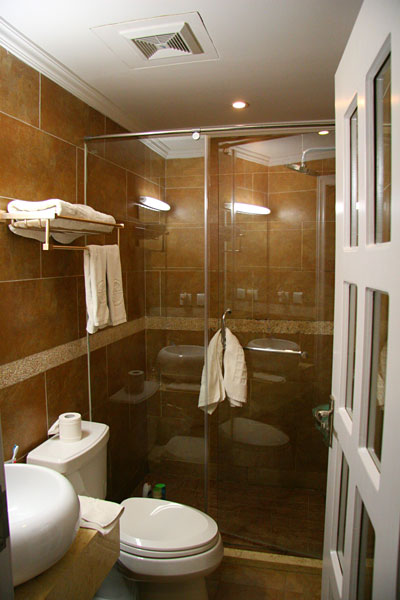
Our only complaint was of the poor drainage in the shower stall, a frequently encountered problem in the mid range hotels of China. So there are caveats and catches, but they’re relatively minor nuisances if you’re the type of traveler who spend most of your time away from the hotel. And why would you waste your time in the room, when there’s a traditional Opera House located practically next door and two kilometers of Suzhou’s best canal neighborhoods to explore around the corner?
